Digital storytelling 2017-18
| Digital storytelling 2017-18
|
|
|
hypertext: definitions
layout vuoto: http://it.wix.com/website/templates/html/blank/1 [galleria immagini] per desktop e mobile
blog: https://whitebirdinablizzardstorytelling.wordpress.com/
mobile: https://apps.wordpress.com/mobile/
********
.M.C. Escher
- huge quantity of information > Vannevar Bush MEMEX (1945)
- augment human efficiency > Douglas Engelbart AUGMENT + NLS-online System
- access to information > Ted Nelson HYPERTEXT 1965 + XANADU PROJECT (docuverse OR a universe of documents)
- paradigm of interaction
- a way to organize information
- a way to create contexts for information
- a mechanism to implement a structure
.
.
.
Nelson writes:
Literature is (among other things) the study and design of documents, their structure and connections.
Therefore today's electronic documents are literature, electronic literature, and the question is what electronic
literature people really need.
Electronic literature should belong to all the world, not just be hoarded by a priesthood,
and it should do what people need in order to organize and present human ideas with the least difficulty
in the richest possible form. A document is not necessarily a simulation of paper. In the most general
sense, a document is a package of ideas created by human minds and addressed to human minds, intended
for the furtherance of those ideas and those minds. Human ideas manifest as text, connections,
diagrams and more: thus how to store them and present them is a crucial issue for
civilization. (italics mine; Xanadu Project)
.
.
FLOWCHARTS
Michael Joyce, Of two Minds, states:
“Electronic writing is both a visual and verbal description”, says Bolter, “not the writing of a place, but rather a writing with places, spatially realized topics […] signs and structures on the computer screen that have not easy equivalent in speech.” For Bolter, hypertext’s “electronic symbols […] seem to be an extension of a network of ideas in the mind itself.”
Kate Pullinger, Inanimate Alice
Heavy Industries, Dakota
Marisha Pessl, Night Film
Amaranth Bursuk and Brad Bouse, Beetween Page and Screen
1923 -TristanTzara’s advised To Make a Dadaist Poem as follows:
Take a newspaper.
Take some scissors.
Choose from this paper an article the length you want
to make your poem.
Cut out the article.
Next carefully cut out each of the words that make up
this article and put them all in a bag.
Shake gently.
Next take out each cutting one after the other.
Copy conscientiously in the order in which they left the bag.
The poem will resemble you.
And there you are—an original author of charming sensibility, even though unappreciated by the vulgar herd.
William Burroughs, “Cut-ups”
Burroughs’ essay "The Cut-Up Method of Brion Gysin" acknowledges this in its first sentence:
.
At a surrealist rally in the1920s TristanTzara the man from nowhere proposed to create a poem on the spot by pulling words out of a hat. A riot ensued wrecked the theater. [. . . ] In the summer of 1959 Brion Gysin painter and writer cut newspaper articles into sections and rearranged the sections at random.
"The cut-up is actually closer to the facts of perception than representational painting. Take a walk down a city street and put down what you have just seen on canvas. You have seen a person cut in two by a car, bits and pieces of street signs and advertisements, reflections from shop windows - a montage of fragments. Writing is still confined to the representational straitjacket of the novel ... consciousness is a cut up. Every time you walk down the street or look out of the window, your stream of consciousness is cut by random factors."
Marc Saporta, Composition N.1 (1964)
Sulla confezione: “TANTI ROMANZI QUANTI SONO I LETTORI. L’ordine delle pagine è casuale: mescolandole, a ciascuno il “suo” romanzo”. Nella prefazione all’edizione originale, Saporta avverte: “Il lettore è pregato di mescolare queste pagine come un mazzo di carte. Di tagliare, se lo desidera, con la mano sinistra, come si fa da una cartomante. L’ordine con il quale le pagine usciranno dal mazzo orienterà il destino di X. Infatti il tempo e l’ordine degli avvenimenti regolano la vita più che la natura degli avvenimenti stessi”.
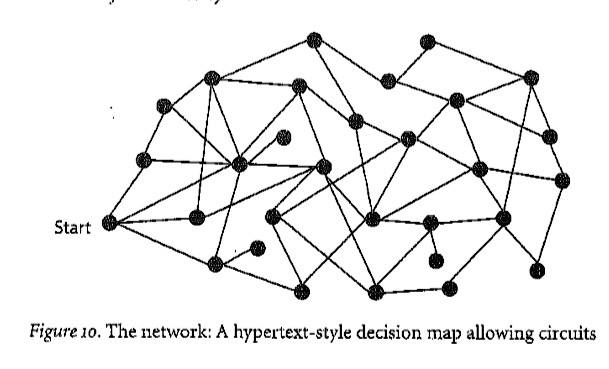
Storyspace
Così scrive Micheal Joyce:Our program, Storyspace, originated as an attempt to develop a text-processing tool to enable writers of interactive
presentations to exploit multiplicities. Storyspace depends on a decisional order rather than a fixed order of presenting material.
(…) A decisional order, however, may be thought of as a series of locales, some of which are linked by linear progression or
argument, but with others that are determined by allusiveness, resemblance, evocation, or unexplained or “intuitive”
parallels determined as often by the author as by the reader. (…) Not long after I first met Stuart Moulthrop, I remember asking
him, in all seriousness, “Do you ever find yourself wanting to press the words on a page of a book you’re reading to see what’s behind
them?” [M. Joyce, Of Two Minds. Hypertext Pedagogy and Poetics, The University of Michigan Press, Ann Arbor (Michigan) 1998,
p. 95.]
.
.
“Electronic writing is both a visual and verbal description”, says Bolter, “not the writing of a place, but rather a writing with
places, spatially realized topics […] signs and structures on the computer screen that have not easy equivalent in speech.” For
Bolter, hypertext’s “electronic symbols […] seem to be an extension of a network of ideas in the mind itself.” Storyspace, the
hypertext system Bolter and I developed with John B. Smith, embodies Bolter’s view that the “topographical” writing of
hypertext” reflects the mind as a web of verbal and visual elements in conceptual space..
.
.
.
.
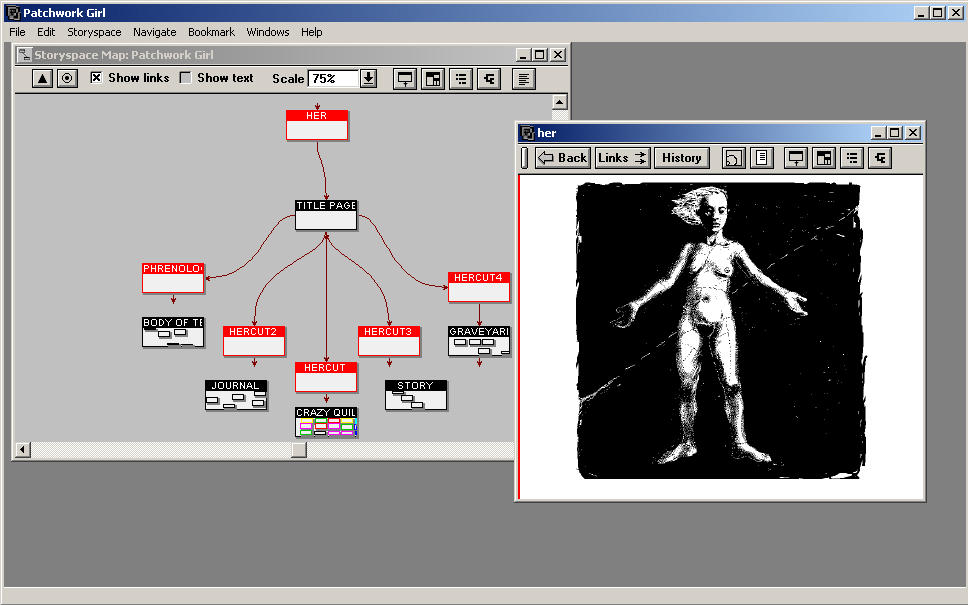
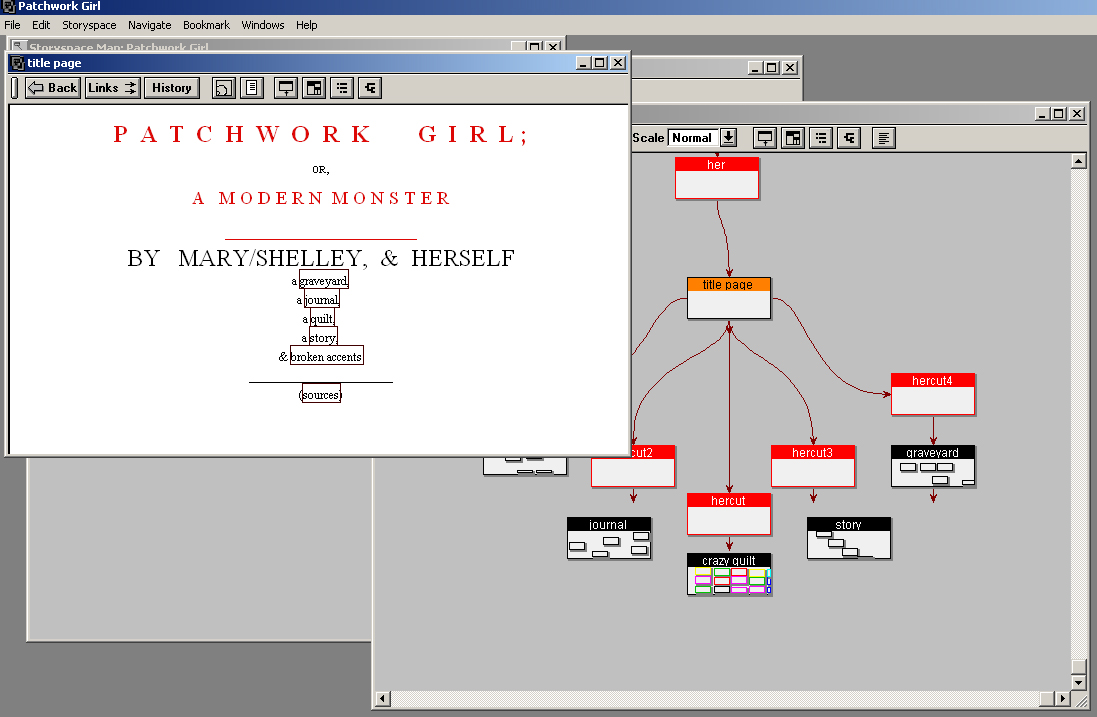
.hypertext
Italo Calvino:
"Lezioni americane" [1]
'iperromanzo":
- luogo "d'infiniti universi contemporanei in cui tutte le possibilità vengono realizzate in tutte le combinazioni possibili";
-dove può valere "un'idea di tempo puntuale, quasi un assoluto presente soggettivo" (Jorge Luis Borges:
Il giardino dei sentieri che si biforcano; racconto della raccolta Finzioni);- dove le sue parti "sviluppano nei modi più diversi un nucleo comune, e che agiscono su una cornice che li determina e ne è determinata";
- che funziona come "macchina per moltiplicare le narrazioni" (Italo Calvino: Se una notte d'inverno un viaggiatore, e
Il castello dei destini incrociati);
Calvino:
« Quando le carte affiancate a caso mi davano una storia in cui riconoscevo un senso, mi mettevo a scriverla; accumulai così parecchio materiale; posso dire che gran parte della Taverna dei destini incrociati è stata scritta in questa fase; ma non riuscivo a disporre le carte in un ordine che contenesse e comandasse la pluralità dei racconti; cambiavo continuamente le regole del gioco, la struttura generale, le soluzioni narrative. Stavo per arrendermi, quando l'editore Franco Maria Ricci m'invitò a scrivere un testo per il volume sui tarocchi viscontei. Dapprincipio pensavo d'utilizzare le pagine che avevo già scritto, ma mi resi conto subito che il mondo delle miniature quattrocentesche era completamente diverso da quello delle stampe popolari marsigliesi. [...] Provai subito a comporre con i tarocchi viscontei sequenze ispirate all'Orlando Furioso; mi fu facile così costruire l'incrocio centrale dei racconti del mio "quadrato magico". Intorno, bastava lasciare che prendessero forma altre storie che s'incrociavano tra loro, e ottenni così una specie di cruciverba fatto di figure anziché di lettere, in cui per di più ogni sequenza si può leggere nei due sensi. »
Georges Perec, Vie Mode d'emploi (1978) (La vita, istruzioni per l'uso)
- "costruito da molte storie che si intersecano"
-"macchina per ispirare racconti"
- «qualche minuto prima delle otto di sera»del 23 giugno 1975
- 1875 -1975
Georges Perec - Interview https://www.youtube.com/watch?v=AwMTvi3XdPU.
.
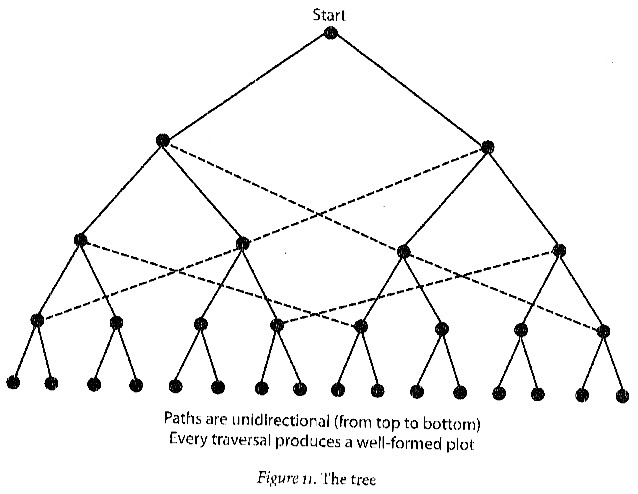
Choose your own Adventure >>> mappings
Choose your own Adventure: Tax Edition:
Drago, A criminal mind http://www.theincipit.com/2017/11/a-criminal-mind-drago/7/
Database
Norman Klein, Bleeding Through the Layers of Los Angeles
Deena Larsen, Marble Springs 3.0 Home
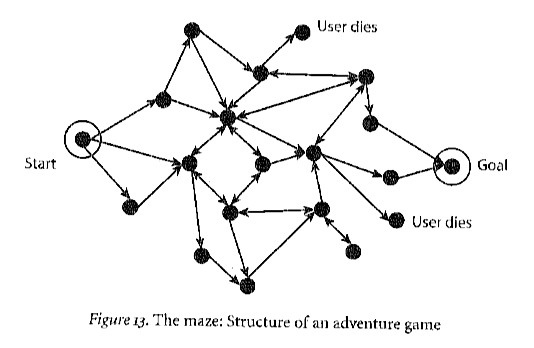
Shooter games
Hidden stories
[imgs from M.-L. Ryan, Narrative as Virtual Reality 2, Johns Hopkins U.P. 2015]
HYPERTEXT IS A NET OF POSSIBILE READINGS
Jorge Luis Borges, The Garden of Forking Paths ---------------- pdf
HYPERLINK
1. link as a possible world in the temporal sense
2. alternative version of the text > point of view
3. shift perspective > follow another plot line
4. control the reader's progress
5. analogical relations between segmetns
6. closer look >> expand decription
7. interrupt the flow of the narration, puzzlel undermine
8. provide background info, explanation
9. let the machine going
IMMERSION
Temporal immersion
suspense
curiosity
surprise
Spatial immersion
form
content
Emotional
Torna.